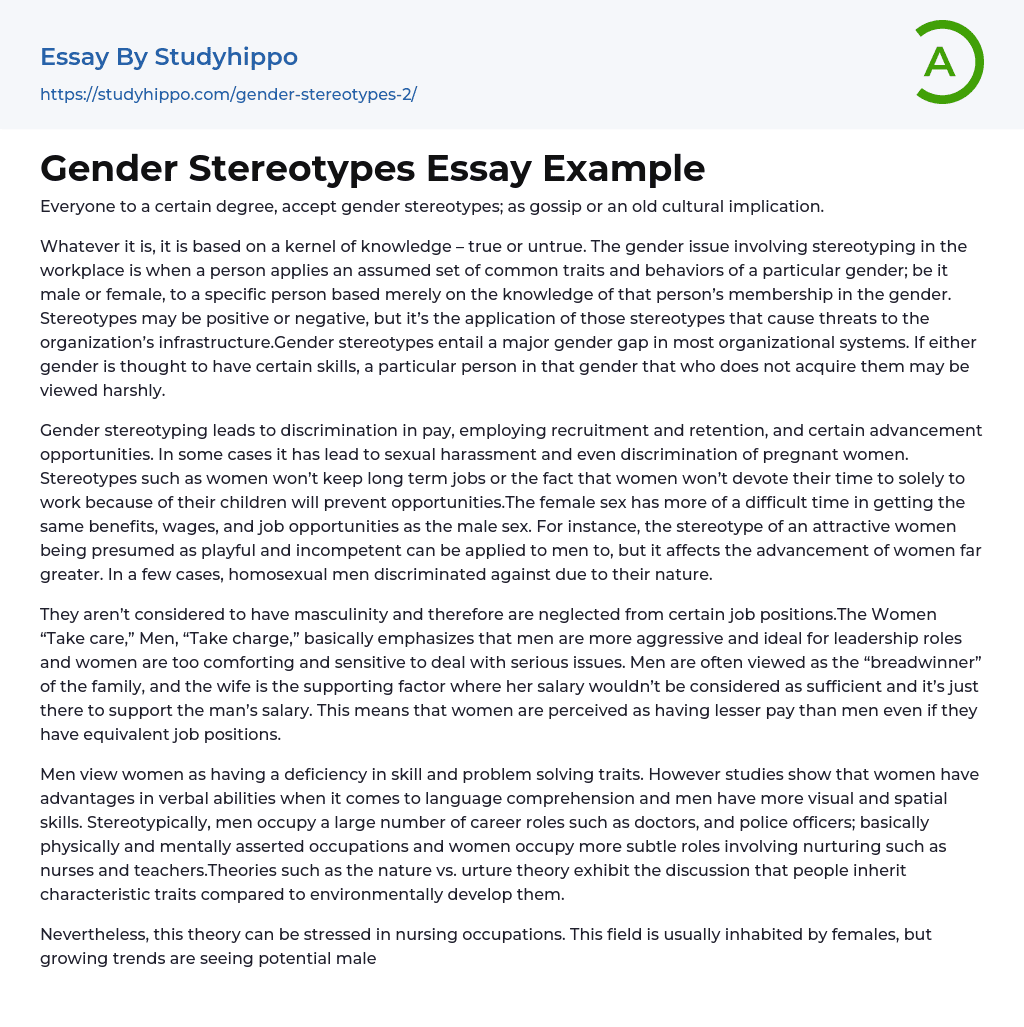Gender stereotypes are commonly accepted by individuals, either through hearsay or as an enduring aspect of traditional societal norms.
Gender-based assumptions about an individual's traits and behavior can create stereotypes in the workplace. These stereotypes, whether positive or negative, are detrimental to the organization as they result in disparities within its systems and harsh judgments towards individuals who do not conform to gender-associated skills.
Gender stereotyping can cause discrimination in pay, recruitment, retention, and advancement opportunities. This can also result in sexual harassment and discrimination against pregnant women. Unfortunately, many believe that women prioritize childcare or are unsuitable for long-term jobs, which limits their career prospects. In contrast, men often have greater access to benefits, wages, and job opportunities than women. While males may also experience gender stereotypes, it has a more significant impact on
...females' career growth as they are frequently perceived as naive and incompetent due to physical appearance. Homosexual men may also face discrimination based on their sexual orientation.
Gender discrimination is common in job positions, favoring those perceived as masculine and disadvantaging others. This reinforces the notion that men are more suited for leadership roles due to their aggressiveness, while women may be viewed as too nurturing and sensitive. The result is the pervasive belief that men should "take charge" whereas women should "take care." Furthermore, pay disparities persist between genders, with men often seen as primary breadwinners and women as secondary earners despite holding comparable job positions.
Research shows that women are often perceived by men as lacking in problem-solving skills and proficiency, despite excelling in verbal language comprehension. Conversely, men tend to excel at visual and spatial abilities. Traditional gender stereotype
result in men dominating physically and mentally demanding professions such as doctors and police officers, while women take on nurturing roles like nurses and teachers. Theories surrounding nature versus nurture propose that characteristics may either be inherited or developed through environmental factors.
The idea that men are not suited for nursing roles due to a lack of nurturing and caring qualities is a gender stereotype that is no longer acceptable, despite being commonly held. This view is being challenged as the nursing profession increasingly attracts interest from potential male candidates. Discrimination in any form, regardless of gender, is prohibited by the US Supreme Court as it relies on harmful gender stereotyping. Our society has ingrained the notion that women should be inherently feminine and men should be inherently masculine; however, there are nuances between these extremes that often go unnoticed.
Gender stereotypes can result in discrimination for both genders. The stereotype of masculinity excludes homosexual men who are often labeled as feminine, leading to unjust treatment. Women experience more discrimination due to gender stereotypes while men are expected to be aggressive. However, the field of male nursing demonstrates the changing perceptions of gender roles.
Gender stereotypes have historically confined women to nurturing roles, but these can be adapted to fit job demands. These biases have also hindered women's representation in senior management positions due to assumptions of their prioritization of family responsibilities. It is crucial for companies to acknowledge that their knowledge capital is their most valuable asset and make efforts to nurture and advance talent regardless of gender.
In order to stay competitive, it is important for companies to embrace innovation and have a diverse workforce that includes
individuals of all genders and sexual orientations. Gender stereotyping is an essential aspect of diversity that requires the use of resources like employee handbooks and on-the-job aids to educate employees. Instead of instructing men about feminism or women about masculinity, management can establish a gender diversity program designed to inform workers about inaccurate stereotypes. By understanding this issue, both genders can move beyond traditional male and female roles.
One way for companies to improve performance evaluations is to focus on behavior and solicit feedback from multiple sources for a more comprehensive view. Management can also conduct checks on employee behavior and ensure integration into the organizational culture to prevent stereotyping. Upper management should receive training on the effects of stereotyping on productivity and profitability, and use strategies such as presenting counter-stereotypical scenarios. Recognizing the accomplishments of women in traditionally male-dominated roles is also recommended.
This would guarantee that the business's image focuses on promoting personnel based on their performance rather than their gender or sexuality.
- Social Construction of Gender essays
- Boy essays
- Gay essays
- Gender essays
- Gender Identity essays
- Gender Roles In Society essays
- Gender Stereotypes essays
- Girl essays
- Homosexuality essays
- Human Sexual Behavior essays
- Lgbt essays
- Man essays
- Masculinity essays
- Sexual Orientation essays
- Transgender essays
- Woman essays
- Anthropology essays
- Audience essays
- Charity essays
- Cultural Competence essays
- Emile Durkheim essays
- Gender Roles essays
- Generation essays
- Globalization essays
- Interpersonal Relationship essays
- People essays
- Race essays
- Social Change essays
- Social Class essays
- Social Movement essays
- Social Science essays
- Social Status essays
- Social Stratification essays
- Society essays
- Sociological Imagination essays
- Sociological Perspective essays
- Sociological Theories essays
- Stereotypes essays
- Web Dubois essays




